Standards and Decision Making Paper
Added on 2022-11-26
27 Pages6315 Words365 Views
1
Standards and Decision Making Paper
A Nepali speaking 75 years old woman (Mrs. X) was transferred from the emergency
department to the general ward for exacerbation of COPD (chronic obstructive pulmonary
disease) along with influenza A. The urinary catheter was removed from four days after the
admission in the general ward in order to ensure the normal function of the urinary bladder.
The patient was monitored for trial of voiding with the help of catheterization as documented
on the patients' notes. During the trial session of voiding the output of urine, the approximate
output was 100 mls in 2 days (48 hours). Patients complained of pain in the lower side of the
abdomen along with no further urge for urination. The abdominal assessment revealed a
distended abdomen. The scan of the bladder was done and it was found that 530 mls of urine
is still inside the bladder.
The main standards of practice that is required at this time include critical thinking to
highlight the clinical priority followed by a consultation of the allied healthcare professionals.
The decision made by the nurse is the removal of the stored urine from the urinary bladder
with the help of the catheter. Proper documentation was done to denote the amount of fluid
input and output along with documentation of the vital signs of the patients to denote any
possible implications for deterioration.
Social history
Mrs. X lives alone in her rented unit in South Australia after the death of her husband.
She receives a pension from Centrelink. She was a house-wife and is not well-equipped in
English and also has restricted the ability to perform activities of daily living. She also has a
limited social life because of her difficulty in walking while maintaining the body balance
and inability to communicate correctly in English. She is more comfortable in Nepali.
Name: MUHAMMAD HUMAYNUL ISLAM NURS3002 Assignment 3 Student ID: 2164328
Standards and Decision Making Paper
A Nepali speaking 75 years old woman (Mrs. X) was transferred from the emergency
department to the general ward for exacerbation of COPD (chronic obstructive pulmonary
disease) along with influenza A. The urinary catheter was removed from four days after the
admission in the general ward in order to ensure the normal function of the urinary bladder.
The patient was monitored for trial of voiding with the help of catheterization as documented
on the patients' notes. During the trial session of voiding the output of urine, the approximate
output was 100 mls in 2 days (48 hours). Patients complained of pain in the lower side of the
abdomen along with no further urge for urination. The abdominal assessment revealed a
distended abdomen. The scan of the bladder was done and it was found that 530 mls of urine
is still inside the bladder.
The main standards of practice that is required at this time include critical thinking to
highlight the clinical priority followed by a consultation of the allied healthcare professionals.
The decision made by the nurse is the removal of the stored urine from the urinary bladder
with the help of the catheter. Proper documentation was done to denote the amount of fluid
input and output along with documentation of the vital signs of the patients to denote any
possible implications for deterioration.
Social history
Mrs. X lives alone in her rented unit in South Australia after the death of her husband.
She receives a pension from Centrelink. She was a house-wife and is not well-equipped in
English and also has restricted the ability to perform activities of daily living. She also has a
limited social life because of her difficulty in walking while maintaining the body balance
and inability to communicate correctly in English. She is more comfortable in Nepali.
Name: MUHAMMAD HUMAYNUL ISLAM NURS3002 Assignment 3 Student ID: 2164328
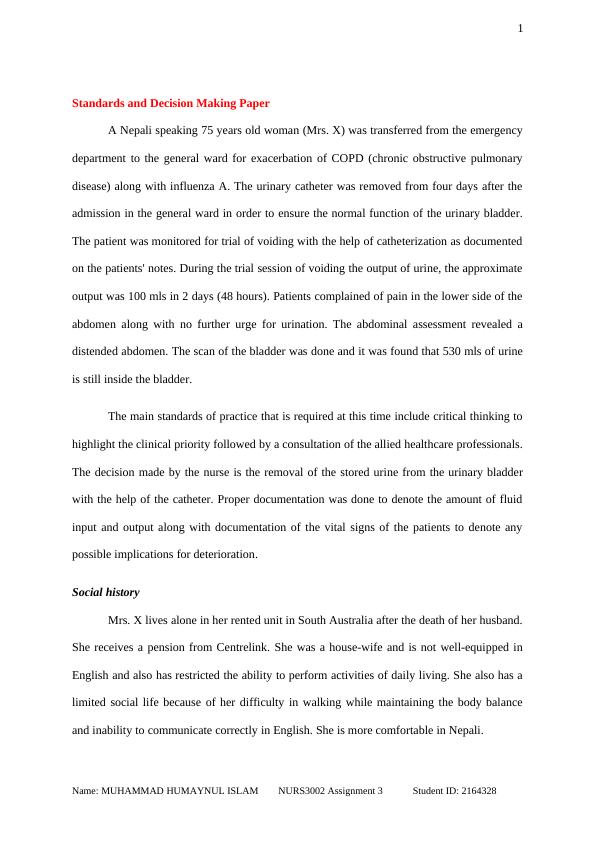
2
Part 1: Nursing Standards
1. Critical thinking and analysis of nursing practice
According to the Nursing and Midwifery Board of Australia (NMBA) (2017), the
standard one of nursing practice it is the duty of the nurse to comply and practice as per the
prevalent legilations and local polices. Under this standard critical thinking, highlighting
clinical priority of the patient and clear yet accurate documentation of patients’ health
statistics is also important. Documentation of the patients’ health parameters in legible and
accurate format is again supported by the National Safety and Quality Health Service
Standards (NSQHSS) by the Australian Commission on Safety and Quality in Healthcare
(ACSQH) (2012). As per the NSQHS Clinical Handover (standard 6) is an important aspect
of improving safety quotient in the therapy plan. The event of care that aligns with this
nursing professional standard is documentation of the health parameter of patient X. The
registered nurse asked me to maintain comparative documentation of the patients’ urine
output, the volume of the abdomen (distended abdomen if any) and the results of USG
(ultrasound scan) test. Documentation is done in the context of the size, and the condition of
the distended bladder will help to compare the results of the urine excretion and the size of
the abdomen. The documentation of the amount of urine excretion while under trial of
voiding assisted technique will help to understand the functional status of the kidneys.
Documentation of the urine input and output data and comparing with the USG report of the
patients will help to understand internal pathophysiology of the abdomen and the rate of
excretion of urine through catheter and state of urine obstruction (Novaes et al., 2017). `the
overall understanding of the renal functioning of the kidneys as revealed from the process of
effective documentation of patients physical parameters will help in the generation of patient
centred care plan (Mackey & Bassendowski, 2017). Thus the nursing practice highlighted in
the case study goes in accordance with the highlighted nursing standards.
Name: MUHAMMAD HUMAYNUL ISLAM NURS3002 Assignment 3 Student ID: 2164328
Part 1: Nursing Standards
1. Critical thinking and analysis of nursing practice
According to the Nursing and Midwifery Board of Australia (NMBA) (2017), the
standard one of nursing practice it is the duty of the nurse to comply and practice as per the
prevalent legilations and local polices. Under this standard critical thinking, highlighting
clinical priority of the patient and clear yet accurate documentation of patients’ health
statistics is also important. Documentation of the patients’ health parameters in legible and
accurate format is again supported by the National Safety and Quality Health Service
Standards (NSQHSS) by the Australian Commission on Safety and Quality in Healthcare
(ACSQH) (2012). As per the NSQHS Clinical Handover (standard 6) is an important aspect
of improving safety quotient in the therapy plan. The event of care that aligns with this
nursing professional standard is documentation of the health parameter of patient X. The
registered nurse asked me to maintain comparative documentation of the patients’ urine
output, the volume of the abdomen (distended abdomen if any) and the results of USG
(ultrasound scan) test. Documentation is done in the context of the size, and the condition of
the distended bladder will help to compare the results of the urine excretion and the size of
the abdomen. The documentation of the amount of urine excretion while under trial of
voiding assisted technique will help to understand the functional status of the kidneys.
Documentation of the urine input and output data and comparing with the USG report of the
patients will help to understand internal pathophysiology of the abdomen and the rate of
excretion of urine through catheter and state of urine obstruction (Novaes et al., 2017). `the
overall understanding of the renal functioning of the kidneys as revealed from the process of
effective documentation of patients physical parameters will help in the generation of patient
centred care plan (Mackey & Bassendowski, 2017). Thus the nursing practice highlighted in
the case study goes in accordance with the highlighted nursing standards.
Name: MUHAMMAD HUMAYNUL ISLAM NURS3002 Assignment 3 Student ID: 2164328
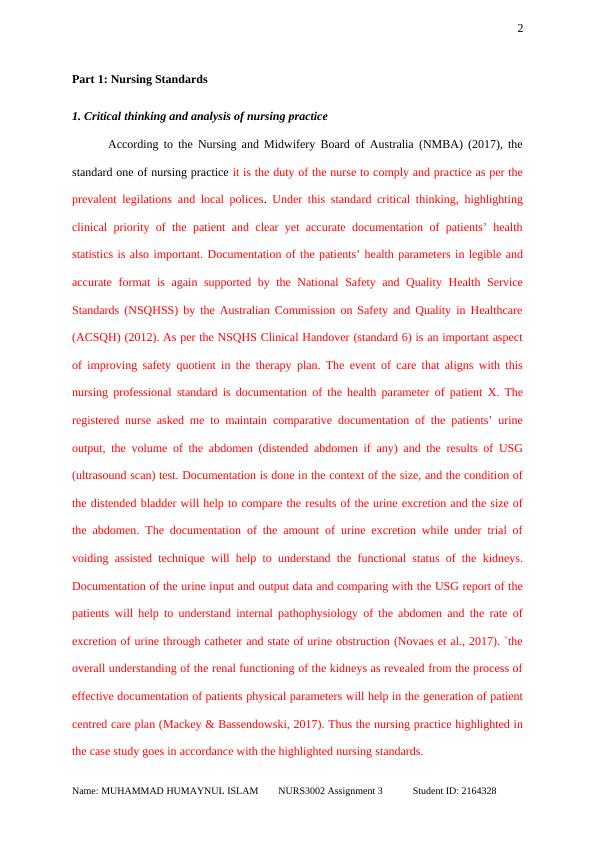
3
2. Engaging in therapeutic and professional relationships
According to standard 2 of NMBA (2017), it is the duty of the nursing professional to
engage in a therapeutic relationship with the client. The generation of therapeutic
relationships helps to improve the overall outcome of patients’ care by increasing the level of
trust among nursing professionals and the patient. In other words, it can be said that the
therapeutic relationship is the primary component of healthcare interactions that facilitates
the development of proper patient-clinician experiences. Standard therapeutic interpersonal
relationships can change the overall experience of the patient in the healthcare service.
Alternatively, with the increase in focus over the patient-centred care, it is imperative for the
healthcare professionals to indulge therapeutically with the patients for improving health-
related outcomes (Kornhaber, Walsh, Duff & Walker, 2016). To develop a therapeutic
relationship with Mrs. X, the nurse executed the use of effective communication. Mrs. X is
Nepali and is not well-versed in English; thus, a professional interpreter is used for the
execution of effective communication skills and the development of a therapeutic
relationship. This again coincides with the standard 1 of nursing practice (1.3). 1.3 specifies
that the nursing professional has to respect the culture and experience of all the patients
irrespective of their ethnicity and cultural backgrounds. The use of transcultural nursing
practises helps to improve the overall performance of the patients (Neilly et al., 2016). Since
my patient was from Nepali origin, my mentor nurse asked me to take help from a
transcultural nurse proficient in Nepali language while communicating with patient X. The
transcultural nurse not only acted as an interpreter but also guided me with the spiritual and
ethical values of the Asian peoples. This understanding further helped to refine my approach
of effective communication and patient education. Patient education is a part of clinical
governance. According to standard 1 of NSQHSS (2012), clinical governance plays a vital
role in improving the safety and quality of the healthcare service. Clinical governance can be
Name: MUHAMMAD HUMAYNUL ISLAM NURS3002 Assignment 3 Student ID: 2164328
2. Engaging in therapeutic and professional relationships
According to standard 2 of NMBA (2017), it is the duty of the nursing professional to
engage in a therapeutic relationship with the client. The generation of therapeutic
relationships helps to improve the overall outcome of patients’ care by increasing the level of
trust among nursing professionals and the patient. In other words, it can be said that the
therapeutic relationship is the primary component of healthcare interactions that facilitates
the development of proper patient-clinician experiences. Standard therapeutic interpersonal
relationships can change the overall experience of the patient in the healthcare service.
Alternatively, with the increase in focus over the patient-centred care, it is imperative for the
healthcare professionals to indulge therapeutically with the patients for improving health-
related outcomes (Kornhaber, Walsh, Duff & Walker, 2016). To develop a therapeutic
relationship with Mrs. X, the nurse executed the use of effective communication. Mrs. X is
Nepali and is not well-versed in English; thus, a professional interpreter is used for the
execution of effective communication skills and the development of a therapeutic
relationship. This again coincides with the standard 1 of nursing practice (1.3). 1.3 specifies
that the nursing professional has to respect the culture and experience of all the patients
irrespective of their ethnicity and cultural backgrounds. The use of transcultural nursing
practises helps to improve the overall performance of the patients (Neilly et al., 2016). Since
my patient was from Nepali origin, my mentor nurse asked me to take help from a
transcultural nurse proficient in Nepali language while communicating with patient X. The
transcultural nurse not only acted as an interpreter but also guided me with the spiritual and
ethical values of the Asian peoples. This understanding further helped to refine my approach
of effective communication and patient education. Patient education is a part of clinical
governance. According to standard 1 of NSQHSS (2012), clinical governance plays a vital
role in improving the safety and quality of the healthcare service. Clinical governance can be
Name: MUHAMMAD HUMAYNUL ISLAM NURS3002 Assignment 3 Student ID: 2164328
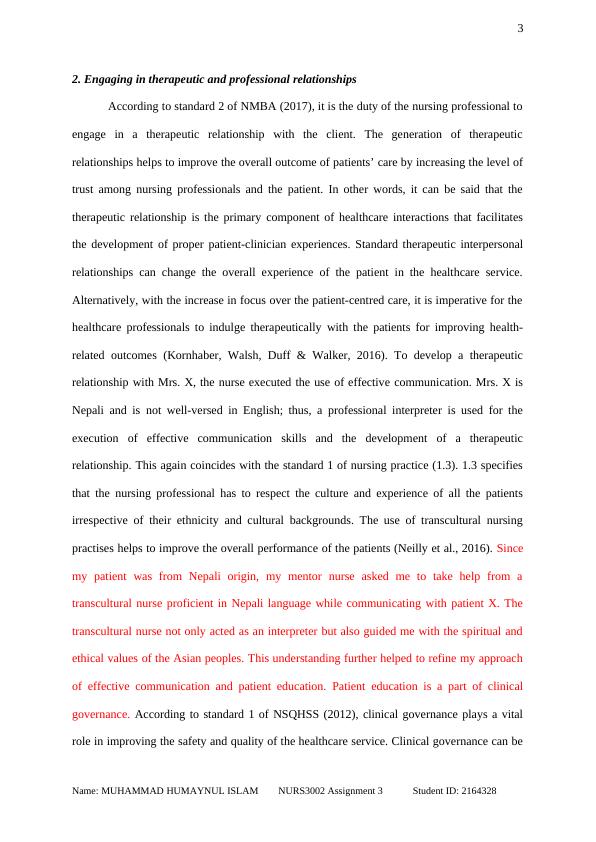
4
achieved by educating the patients about the prospective outcome of care and the path of
disease prognosis. Nabilou, Feizi and Seyedin (2015) stated that educating the patient about
the process of disease progression, helping improve the awareness of the patients about the
disease and thus imposing patients’ engagement. Here, engagement with patient’s X was
done under the presence of transcultural nurse. The presence of transculatural nurse helped to
execute collaborative patient care (2.1 of nursing standards). Mrs. X is suffering from the
exacerbation of COPD (chronic obstructive pulmonary disease) along with influenza A. Thus
education of Mrs. X was directed towards the prognosis of COPD and how healthy lifestyle
habits post-release from the hospital will help to control the severity of the disease. Mrs. X
was educated about the transmission of influenza, contagious disease, and how it can be
controlled. Grohskopf (2016) stated that taking seasonal vaccination for influenza would help
to control disease development. I was aware that the use of the urinary catheter increases the
chances of getting affected with the catheter-associated infection, a form of hospital-acquired
infection (HAIs). Urinary tract infections are one of the common HAIs with 80 to 70%
accounts for catheter-associated urinary tract infections (CAUTIs). The increase in the
domain of patient awareness and patient engagement in the areas like indwelling urinary
catheters and the associated consequences can be effectively improved under the hospitalised
settings. Proper use of the educational program and incorporating the preference of the
patient is likely to enhance the involvement of the patients in the decision-making process
regarding the urinary catheters. So while educating the patients about the catheter and urine
excretion, I also took preference of the patients like whether she is comfortable with opposite
sex nurse in availing the healthcare service and education (Safdar et al., 2016). Thus I
demonstrated respect to patient’s X rights and wishes (2.4 of NMBA standards).
Name: MUHAMMAD HUMAYNUL ISLAM NURS3002 Assignment 3 Student ID: 2164328
achieved by educating the patients about the prospective outcome of care and the path of
disease prognosis. Nabilou, Feizi and Seyedin (2015) stated that educating the patient about
the process of disease progression, helping improve the awareness of the patients about the
disease and thus imposing patients’ engagement. Here, engagement with patient’s X was
done under the presence of transcultural nurse. The presence of transculatural nurse helped to
execute collaborative patient care (2.1 of nursing standards). Mrs. X is suffering from the
exacerbation of COPD (chronic obstructive pulmonary disease) along with influenza A. Thus
education of Mrs. X was directed towards the prognosis of COPD and how healthy lifestyle
habits post-release from the hospital will help to control the severity of the disease. Mrs. X
was educated about the transmission of influenza, contagious disease, and how it can be
controlled. Grohskopf (2016) stated that taking seasonal vaccination for influenza would help
to control disease development. I was aware that the use of the urinary catheter increases the
chances of getting affected with the catheter-associated infection, a form of hospital-acquired
infection (HAIs). Urinary tract infections are one of the common HAIs with 80 to 70%
accounts for catheter-associated urinary tract infections (CAUTIs). The increase in the
domain of patient awareness and patient engagement in the areas like indwelling urinary
catheters and the associated consequences can be effectively improved under the hospitalised
settings. Proper use of the educational program and incorporating the preference of the
patient is likely to enhance the involvement of the patients in the decision-making process
regarding the urinary catheters. So while educating the patients about the catheter and urine
excretion, I also took preference of the patients like whether she is comfortable with opposite
sex nurse in availing the healthcare service and education (Safdar et al., 2016). Thus I
demonstrated respect to patient’s X rights and wishes (2.4 of NMBA standards).
Name: MUHAMMAD HUMAYNUL ISLAM NURS3002 Assignment 3 Student ID: 2164328
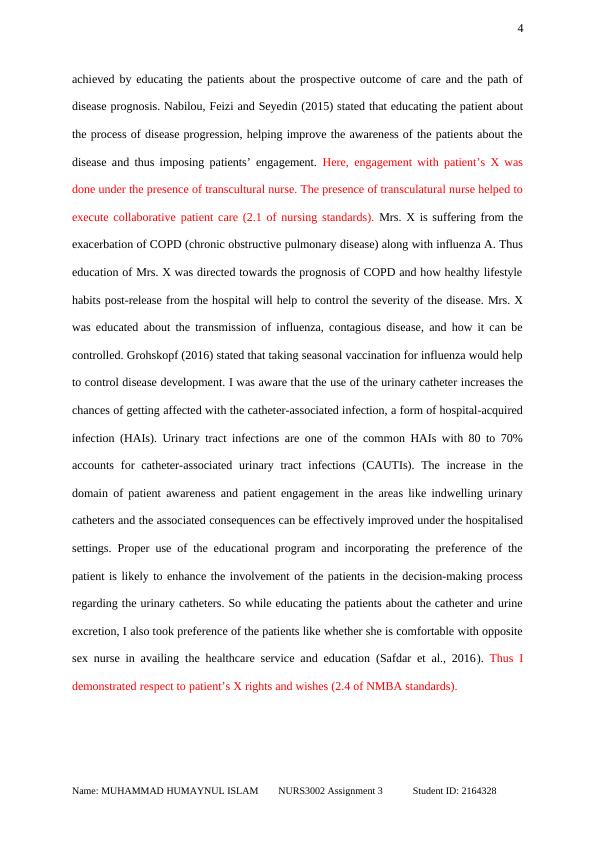
5
3. Maintaining the capability of practice
Acute urinary retention (AUR) is one of the severe complications among older adults;
the overall risks of AUR increases with age. The immediate management of these
complications is urethral catheterization. Transurethral prostate resection (TURP) is used as a
gold standard for definitive treatment. However, studies have shown that the trail voiding
without catheter is more successful in comparison to catheter-associated voiding of the
urinary bladder. Trail of voiding without catheter is defined as point at which the patient can
able to regain self-voiding and recover from AUR (Das et al., 2018). During my initial
placement in the general word of the Lyell McEwin Hospital in South Australia, I was not
aware of the process of trial voiding.
According to standard 3 of the NMBA professional code of conduct (2017), it is the
duty of the attending nurses to provide safe practice by demonstrating commitment to
lifelong learning of self and others. The study conducted by Pool et al. (2015) highlighted
that having a scope for continuous professional development by the nursing professionals
help to increase the knowledge of the nurses about the current approaches highlighted under
the evidence-based practice guidelines and thereby helping to improve the outcome of care.
Price and Reichert (2017) further stated that a student and the early-career nurses are
expected to attain adequate training and education to facilitate the transition under the
workplace. A role of the student nurse or the novice nursing professionals also includes
creating scope for continuing education opportunities throughout their career. Here the event
of care includes self-education or creating scope in increase my knowledge about trial of
voiding.
During my placement in the general ward, I got immense support from my mentor,
registered nursing professional. It is she who helped me to understand the difference between
the catheters associated voiding of the urinary bladder or voiding of the bladder in the
Name: MUHAMMAD HUMAYNUL ISLAM NURS3002 Assignment 3 Student ID: 2164328
3. Maintaining the capability of practice
Acute urinary retention (AUR) is one of the severe complications among older adults;
the overall risks of AUR increases with age. The immediate management of these
complications is urethral catheterization. Transurethral prostate resection (TURP) is used as a
gold standard for definitive treatment. However, studies have shown that the trail voiding
without catheter is more successful in comparison to catheter-associated voiding of the
urinary bladder. Trail of voiding without catheter is defined as point at which the patient can
able to regain self-voiding and recover from AUR (Das et al., 2018). During my initial
placement in the general word of the Lyell McEwin Hospital in South Australia, I was not
aware of the process of trial voiding.
According to standard 3 of the NMBA professional code of conduct (2017), it is the
duty of the attending nurses to provide safe practice by demonstrating commitment to
lifelong learning of self and others. The study conducted by Pool et al. (2015) highlighted
that having a scope for continuous professional development by the nursing professionals
help to increase the knowledge of the nurses about the current approaches highlighted under
the evidence-based practice guidelines and thereby helping to improve the outcome of care.
Price and Reichert (2017) further stated that a student and the early-career nurses are
expected to attain adequate training and education to facilitate the transition under the
workplace. A role of the student nurse or the novice nursing professionals also includes
creating scope for continuing education opportunities throughout their career. Here the event
of care includes self-education or creating scope in increase my knowledge about trial of
voiding.
During my placement in the general ward, I got immense support from my mentor,
registered nursing professional. It is she who helped me to understand the difference between
the catheters associated voiding of the urinary bladder or voiding of the bladder in the
Name: MUHAMMAD HUMAYNUL ISLAM NURS3002 Assignment 3 Student ID: 2164328

6
absence of catheter. I also approached her proactively to clear my doubts and thus helping me
to get a clear perspective of the urinary bladder clearance and role of catheter for in urine
clearance. Thus I recognised and approached when capability of practice is impaired.
Increase in my knowledge about trial of voiding and renal function helped me to understand
quickly the clinical emergency. Thus when I found 530 mls of urine is still inside the bladder,
I immediately alerted by senior nurse telling her that patient’s health requires additional
interventions.
4. Conduction of assessment in a comprehensive manner
Assessment is defined as the systematic and continuous collection, validation and
documentation of information. The information includes the need of the patient, healthcare
problems associated with the patients, lifestyle problems and values (Lewis et al. 2015).
Optimal assessment of an older adult like Mrs. X will focus on her complex needs. As per the
guidelines stated by Clarke and Ketchell (2016), the assessment of an older adult who is
suffering from renal complications or urine retention include the amount to fluid intake, the
output of the urine and the salt or the electrolyte balance within the both. Thus in the general
ward, the assessment of the patient mainly covered the measurement of fluid intake and
output along with blood serum assessment to estimate the slat electrolyte balance. Since Mrs.
X is suffering from an exacerbation of COPD, further assessment can be undertaken in order
to have a detailed perspective of the respiratory status and the cardiac output of the patient.
The risk factor that triggers the development of COPD among the older adults includes
smoking, bronchiectasis causing limitations in the airflow. The presence of bacterial or viral
infection within the pulmonary airways also increases the risk factors for developing COPD.
In the case of Mrs. X it can be said that she is suffering from influenza A thus there is a
visible sign of viral infection within the body. As she is been shifted from emergency to the
general, her viral load in the body might have been reduced but it is the duty of the nursing
Name: MUHAMMAD HUMAYNUL ISLAM NURS3002 Assignment 3 Student ID: 2164328
absence of catheter. I also approached her proactively to clear my doubts and thus helping me
to get a clear perspective of the urinary bladder clearance and role of catheter for in urine
clearance. Thus I recognised and approached when capability of practice is impaired.
Increase in my knowledge about trial of voiding and renal function helped me to understand
quickly the clinical emergency. Thus when I found 530 mls of urine is still inside the bladder,
I immediately alerted by senior nurse telling her that patient’s health requires additional
interventions.
4. Conduction of assessment in a comprehensive manner
Assessment is defined as the systematic and continuous collection, validation and
documentation of information. The information includes the need of the patient, healthcare
problems associated with the patients, lifestyle problems and values (Lewis et al. 2015).
Optimal assessment of an older adult like Mrs. X will focus on her complex needs. As per the
guidelines stated by Clarke and Ketchell (2016), the assessment of an older adult who is
suffering from renal complications or urine retention include the amount to fluid intake, the
output of the urine and the salt or the electrolyte balance within the both. Thus in the general
ward, the assessment of the patient mainly covered the measurement of fluid intake and
output along with blood serum assessment to estimate the slat electrolyte balance. Since Mrs.
X is suffering from an exacerbation of COPD, further assessment can be undertaken in order
to have a detailed perspective of the respiratory status and the cardiac output of the patient.
The risk factor that triggers the development of COPD among the older adults includes
smoking, bronchiectasis causing limitations in the airflow. The presence of bacterial or viral
infection within the pulmonary airways also increases the risk factors for developing COPD.
In the case of Mrs. X it can be said that she is suffering from influenza A thus there is a
visible sign of viral infection within the body. As she is been shifted from emergency to the
general, her viral load in the body might have been reduced but it is the duty of the nursing
Name: MUHAMMAD HUMAYNUL ISLAM NURS3002 Assignment 3 Student ID: 2164328
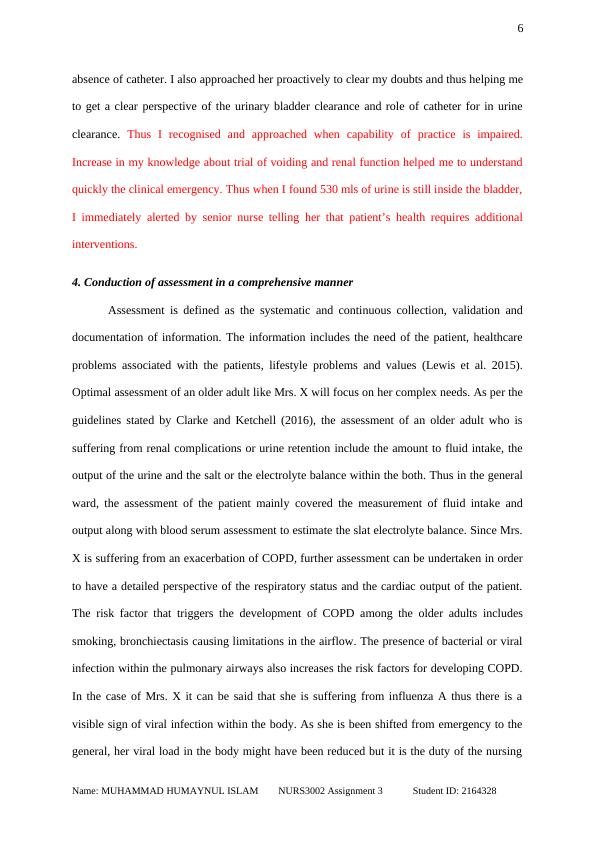
End of preview
Want to access all the pages? Upload your documents or become a member.
Related Documents
Assignment on the Job Functions of Nursinglg...
|11
|3730
|265
Clinical Reasoning Cycle for Hypovolemia, Dehydration and Hypotensionlg...
|6
|1448
|220
Nursing Evidence Based Practicelg...
|12
|2895
|56
Nursing Case Study Assignment (Doc)lg...
|14
|3335
|125
Bachelor of Nursing Case Study 2022lg...
|8
|2160
|37
